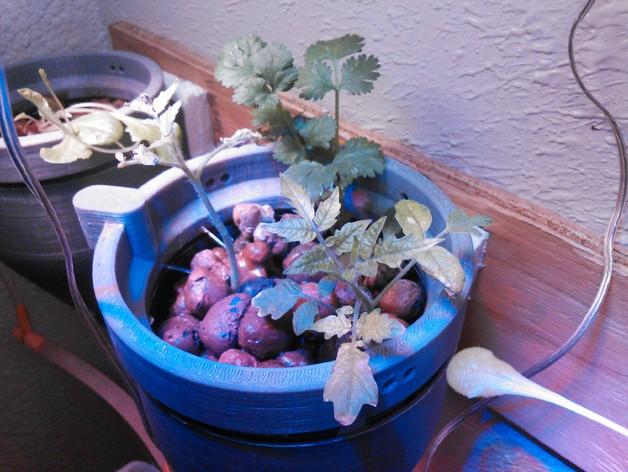I started a vegetable garden for the first time in years this spring, and I have to admit, it is not going well. Don’t get me wrong: I know how to grow plants, and even pride myself in having a green thumb. But for ![]() some reason, this time around things just aren’t growing as I expected them to. The plants are all in containers and I keep wondering if perhaps I am watering them too much or too little. In the meantime, while waiting to see what the ultimate verdict is on this spring garden experiment, my attention moves towards garden watering projects like this 3D printed hydroponic bottle rim from Thingiverse.
some reason, this time around things just aren’t growing as I expected them to. The plants are all in containers and I keep wondering if perhaps I am watering them too much or too little. In the meantime, while waiting to see what the ultimate verdict is on this spring garden experiment, my attention moves towards garden watering projects like this 3D printed hydroponic bottle rim from Thingiverse.
Hydroponics is an ancient agricultural practice for growing plants; it eliminates the need for soil, using mineral nutrient solutions in water instead. In modern times, we hear the term used frequently for indoor growing systems – especially when it comes to the activity of cannabis cultivation. This 3D printed bottle rim with sprinkler, designed by Chase Yamate, is a very simple contraption that allows you to establish a simple hydroponics system using a 2 liter bottle and a 3D printed rim.
Here Yamate explains the project in detail:
“[It] takes 4 zip ties to fasten it to the bottle, and has 6 small holes to water your plants. be very careful with the inlet nozzle, if it breaks you’ll have to print an other one. I run three of these with the smallest pump I could find at Harbor Freight ($8). I’ve been playing with the diameter of the water holes and how many of them. I think i finally got it right so that a 3/16″ piece of tubing can drain the bottle fast enough.”
The idea is that water is released through the holes, running through the rocks (as seen in the photo) so you can keep the appropriate amount of moisture going for the plant at all times.
For more detailed 3D printing instructions, Yamate (who used a HICTOP Prusa i3 for this project) explains that the rim should be printed at 100% infill and 0.2 mm resolution, using ABS only. ABS is strong enough to handle the inlet nozzle’s strength, and it leaks less water. Your print orientation will be upside down, with a 20% grid at 90 degrees, touching the base-plate only. And don’t forget to use a 10 layer brim, also.
Now that I have seen non-soil based alternatives for growing plants, I am seriously considering hydroponics instead of all the cumbersome soil-filled containers that may not be draining so well. If you are interested in trying this out using Yamate’s Hydroponics 2 Liter Bottle Rim, post your results on Thingiverse (at Yamate’s request). He has been working on this project for several weeks now and would like to see other people’s makes, especially if you come up with any revisions. Discuss in the 3D Printed Hydroponics forum over at 3DPB.com.
Subscribe to Our Email Newsletter
Stay up-to-date on all the latest news from the 3D printing industry and receive information and offers from third party vendors.
You May Also Like
Precision at the Microscale: UK Researchers Advance Medical Devices with BMF’s 3D Printing Tech
University of Nottingham researchers are using Boston Micro Fabrication‘s (BMF) 3D printing technology to develop medical devices that improve compatibility with human tissue. Funded by a UK grant, this project...
3D Printing Webinar and Event Roundup: April 21, 2024
It’s another busy week of webinars and events, starting with Hannover Messe in Germany and continuing with Metalcasting Congress, Chinaplas, TechBlick’s Innovation Festival, and more. Stratasys continues its advanced training...
3D Printing Webinar and Event Roundup: March 17, 2024
It’s another busy week of webinars and events, including SALMED 2024 and AM Forum in Berlin. Stratasys continues its in-person training and is offering two webinars, ASTM is holding a...
3D Printed Micro Antenna is 15% Smaller and 6X Lighter
Horizon Microtechnologies has achieved success in creating a high-frequency D-Band horn antenna through micro 3D printing. However, this achievement did not rely solely on 3D printing; it involved a combination...































